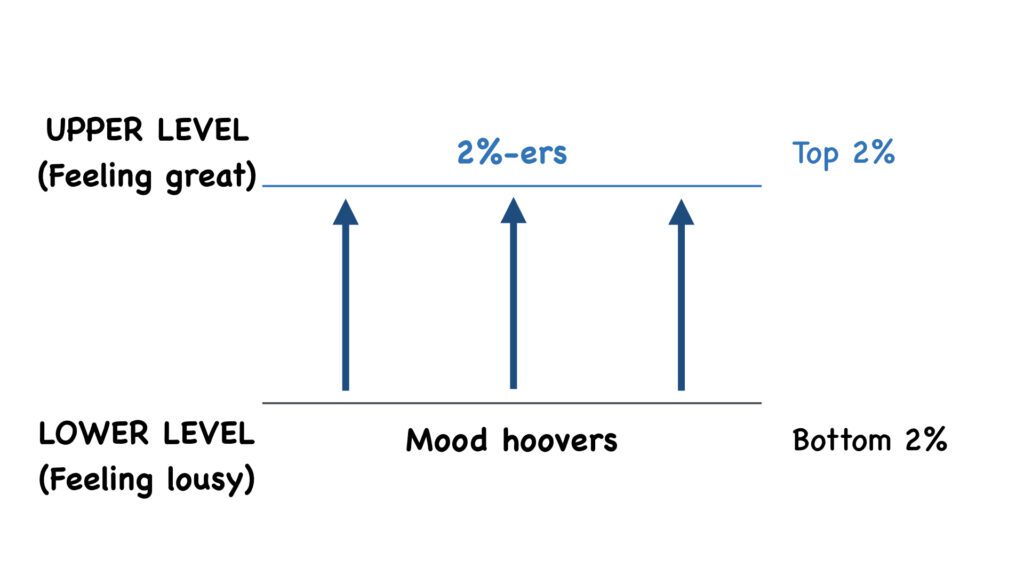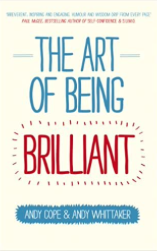Book Review #2 - The Art Of Being Brilliant
The Book In 3 Sentences
- Aim to be a 2%er with a positive attitude and mindset.
- Conversely, you should not be a mood hoover (i.e. always complaining and being miserable, counting down until the weekend) and also not surround yourself with these people.
- Set Huge Unbelievably Great Goals (HUGGs) that excite you, but will push and challenge you to achieve them.
💡 How We Discovered It
It was recommended in one of our lectures at Loughborough University, and then the authors came to do a talk at the university so we of course went!
📚 Who Should Read It?
Anyone and everyone! We’ve recommended this book to so many different people since we first read it a few years ago. We’ve also re-read on several occasions to remind ourselves of the powerful messages it conveys!
✍️ Our Top 3 Quotes
- The difference between ‘try’ and ‘triumph’ is just a little “umph”.
- The average child laughs about 400 times per day. The average adult laughs only 15 times per day. What happened to the other 385 laughs?
- It’s impossible to live without failing at something, unless you live so cautiously that you might as well not have lived at all – in which case, you fail by default. (JK Rowling)
📒 Our Book Review
Most people believe that ‘happiness’ is something that is out there to be found (such as winning the lottery or getting a promotion) however The Art Of Being Brilliant is all about positive psychology and how happiness is actually internal.
Generally, the word psychology has negative connotations. It is concerned with studying people’s problems and fixing people.

Most people are stuck in the lower half of the diagram – not clinically depressed, just in a cycle of negativity. These people are “fine” most of the time, and their mood depends on what happens during the day. Right at the bottom of the diagram are the mood hoovers: someone who has a problem for every solution.
Unfortunately, everyone knows a few mood hoovers. Just being around them for a few minutes can bring your energy down and you find yourself starting to complain more too!
In contrast, at the top of the diagram we have the 2%ers.
This is why we need to be a 2%er and also surround ourselves with likeminded people who are also 2%ers. As motivational speaker Jim Rohn would say: “You are the average of the five people you spend the most time with.” Check out this YouTube video for further detail into this concept and the compound effect.
The Art Of Being Brilliant looks at 6 ways to be a 2%er: how to feel happiness, positivity, energy and passion more often.
How To Be A 2%Er
#1 – Choose To Be Positive
In the lower end of the diagram above, people have ‘destination addiction’ – counting down until the next event. We’ve all done it before! But we shouldn’t be wishing our days or weeks away – we don’t have enough of them to do that!
The Art Of Being Brilliant makes it clear: being positive isn’t easy! Most people are negative, and humans like to fit in – so it’s easier to be negative.
But being positive has so many benefits, especially in sport (ideas also taken from Psychology.net and The Sport Pysch Show Podcast):
For example, positive thinking has shown that athletes who get nervous and anxious before a match with “butterflies in the stomach” can see these characteristics as helpful for their performance, and not a hindrance.
Another brief example is that positive thinking leads to improved self-confidence. Confidence is extremely important, helping skill execution and overall performance.
One example that we can both draw upon is when we’ve been injured, spending weeks on crutches and in a boot. Rather than seeing these injuries as a huge disaster and moping around, we saw them as opportunities to focus on areas such as upper body strength – something that is considered a work area in both of our games.
So we spent these weeks focusing immensely on rehabilitation and upper body strength, taking the lesson of being 2%ers on-board and never complaining – because at the end of the day, we were still professional athletes training to become better (albeit in a slightly different way)!
#2 – Understand Your Impact
We have to understand our influence and impact we have on people. Although we don’t always realise it, we impact everyone that we meet – even if we just meet them for 1 minute. So, we may as well aim to make the impact a positive one!
As we mentioned earlier, being positive isn’t easy. But positive people choose to be positive. So two questions we should always ask ourselves are: how can I deliberately create a feel-good factor in people around me? How can I inspire those people?
#3 – Take Personal Responsibility
The Art Of Being Brilliant suggests that 10% of life is made up of what happens to you, and the other 90% is decided by how you react to the 10%. This is where we must strive to be 2%ers, reacting differently to mood hoovers and those in the lower end of the diagram.
For example, being a 2%er when your opponent makes a bad call means that you instantly move on and focus on the next rally. If you choose not to be a 2%er, then you swear at your opponent and argue with them, your focus spirals out of control and you lose the next 10 points in a row. (We’ve seen it happen before)!
Brilliantly put in the book: garbage in, garbage out. Lots of people put in low energy and negativity, and expect energetic and positive results! You have to put in the work, enthusiastically and positively, to gain positive results. Once again, changing your habits can be hard, but life-changing. If you want to read more about this topic, check out our blog post on Atomic Habits which discusses habits in more detail.
#4 – Have Bounce-Back-Ability
Everyone can have a bad day, but it’s their ‘bounce-back-ability’, or resilience, that is important.
2%ers get through these times and bounce back to ‘being fabulous’ because they know the current situation isn’t permanent. Move forward positively, rather than wallowing in negativity.
#5 – Set Huge Goals
We hear of so many people who say that they don’t want to set their goals and ambitions too high, as they are afraid they’ll be disappointed if they don’t achieve it. This leads to them aiming for averageness.
For example, if you had a HUGG of representing your country at a major event but didn’t want to be disappointed so only set your sights on representing your club – you will probably end up disappointed anyway because you will always wonder what else you could have achieved. The book talks about how you can often achieve a lot more by setting these huge goals, and often actually achieve this HUGG goal, no matter how ambitious it is.
A HUGG should excite you!
HUGGs are our biggest takeaway from this book. After reading about HUGGs, we instantly knew that we had been missing out by not setting ourselves these huge goals, and we had to implement it into our lives straight away. It’s something we still regularly apply to all aspects of our lives, dreaming and believing that one day we will achieve this amazing goal.
It is important to note that as HUGGs are often long-term goals, you should set yourself some rewards along the way to keep you motivated! These are known as ‘quick wins’ where you can see that you have progressed in your mission to achieve the overall goal.
#6 – Play To Your Strengths
Playing to your strengths is important in general life, but even more important on the badminton court! You have a better chance of winning the rally if you are playing to your strengths.
For example, if your attack from your round-the-head corner is amazing, you should try to set this up as much as possible. And, you have a better chance of doing something well (e.g. attacking from your round-the-head corner) if you are really confident in doing it.
Of course, we can’t ignore our weaknesses. We should always work on them if they are holding us back, but generally, successful people play to their strengths!
If we only ever tried to slightly improve our weaknesses so they are no longer glaringly obvious, we become subject to the curse of mediocrity. This is where you become average at everything with no obvious weaknesses, but not great at anything to enable you to succeed or stand-out. This is similar to the 80-20 rule, also known as the Pareto Principle, whereby 80% of outcomes (or outputs) result from 20% of all causes (or inputs) for any given event. You should therefore focus on the 20% of your game that is causing 80% of your wins.
This is so important that we actually often have “super strength” sessions, where we solely focus on further improving our current strengths on-court.
To summarise, the 6 ways to be a 2%er are:
- Choose to be positive
- Understand your impact
- Take personal responsibility
- Have bounce-back-ability
- Set HUGGs
- Play to your strengths
There are so many great lessons and tips from this book that we have applied to our lives since reading it a few years ago. We would strongly recommend you to read the book too (it’s less than 200 pages!). You can get it on Amazon here.
If you’ve enjoyed this book review we’d really appreciate if it you shared it with a friend, especially if you know a mood hoover! And of course get yourself a copy of the book 🙂
Resources Mentioned:
Pyschology.Net – http://psychology.iresearchnet.com/sports-psychology/psychological-skills/positive-thinking-in-sport/
The Sport Pysch Show Podcast by Dan Abrahams
Atomic Habits Book Review – https://badminton-insight.com/book-review-1-atomic-habits/
Pareto Principle – Developed by Pareto 1896


